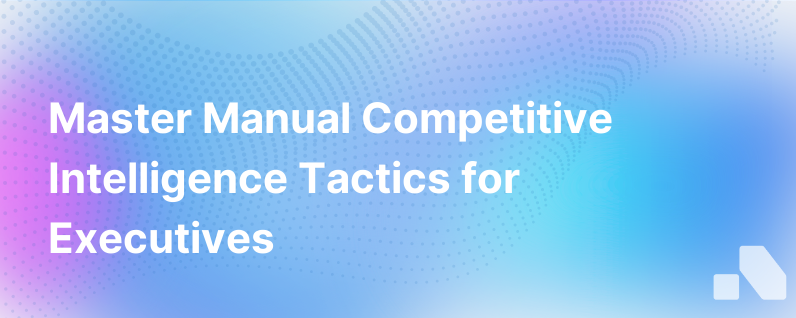
In today's dynamic marketplace, keeping a finger on the pulse of your competition is critical. The ability to cut through the noise and gather meaningful, actionable insights from competitor activities can profoundly impact your strategic endeavors. Choosing the right tactic to gather this information, however, poses an interesting challenge: Manual competitive intelligence.
Exploring Manual Competitive Intelligence
Competitive intelligence (CI) refers to the collection and analysis of information about competitors, market trends, and other external factors influencing business planning and execution. It involves systematic tracking of competitors' products, market share, marketing strategies, customer feedback, and industry developments, transforming this information into relevant business insight.
Manual competitive intelligence involves human analysts painstakingly carrying out the CI process, absent of automated solutions. It underscores the importance of human intervention for nuanced understanding and in-depth insights.
Advantages of Manual Competitive Intelligence
Despite the surge in automated CI tools, manual competitive intelligence offers unique advantages that are hard to replicate with software. These include:
Richer, Deeper Insight: Manual investigation tends to provide more detailed knowledge of a competitor, something machine learning-driven tools might lack. Human analysis can incorporate elements of emotion, intuition, and tacit knowledge, offering richer, more intuitive findings.
Custom Analysis: Manual methods offer the opportunity to tailor investigations specifically for your unique business requirements. Analysts can dig deeper into areas of concern, highlight specific points of interest, and customize reports to suit your business needs.
Understanding Complexity: Complex variables or trends that confuse algorithms are relatively easier for humans to interpret and navigate. Especially in the interpretation of qualitative data, humans can beat AI tools due to their innate ability to understand complex scenarios.
Challenges of Manual Competitive Intelligence
Manual CI does have its drawbacks, which include:
Time-Intensity: Manual intelligence gathering, especially in larger-scale operations, is time-consuming. Filtering out irrelevant information and organizing data can be basically a full-time job.
Analysis Paralysis: The information overload can sometimes lead to analysis paralysis. Decision-makers may feel overwhelmed by sheer volume of data, slowing down strategic development.
Outdated Information: In an age where data updates by the second, manually gathered insights can become obsolete quickly.
Steps to Set Up Manual Competitive Intelligence
Here are some steps that can help streamline your manual CI process:
1. Identify Your Competitors: The first step is to identify who your competitors are. Direct competitors are those who make a similar product or service to yours for the same audience. Indirect competitors can be those who offer products or services similar enough to potentially take business away from you.
2. Determine What You Want to Know: Define what kind of information is most valuable to you and your team. Typical areas for investigation could include product development, marketing strategies, customer sentiments and experiences or pricing models.
3. Select Your CI Sources: Choose where to gather this information. Common sources include competitors' websites, online customer reviews, social media commentary, and industry-specific reviews or blogs.
4. Collect and Collate Information: Use these identified sources to gather as much relevant information as you can. Keep meticulous records in shared documents or spreadsheets.
5. Analyze Data: With your data collected, it's time for analysis. Look for emerging patterns, areas of tension, identified strengths or weaknesses, and gather insight from these findings.
6. Look Out for Triggers: Make sure to monitor for signals or triggers that might indicate potential strategic changes. These could include new hires in executive positions, funding rounds, acquisitions, partnerships or new product launches.
7. Regularly Update Your Information: Given the dynamic nature of the marketplace, it's crucial to regularly update your information for relevancy and effectiveness.
Navigating the competitive landscape successfully requires a profound understanding of your competition’s various aspects. Manual competitive intelligence plays a significant role in this journey, offering important insights derived from careful human evaluation.
However, in a world where real-time data updates are crucial, the time and effort-consuming aspects of manual work can slow you down. It's here that Aomni emerges as a solution, a platform that combines the accuracy of AI with the familiarity of user feedback. By offering real-time account research, competitive insights, and automated update features, it brilliantly marries the value offerings of both manual and automated CI, aiding you in maintaining your competitive edge effectively.